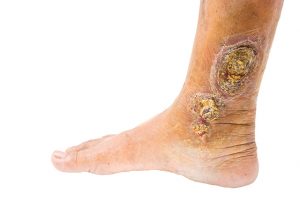
Buruli ulcer – causes, side effects and treatments at NaturalPedia.com
Wednesday, February 07, 2018 by Ralph Flores
http://www.naturalpedia.com/buruli-ulcer-causes-side-effects-and-treatments-at-naturalpedia-com.html

Buruli ulcer is an infection that causes severely deformed sores in the skin and the soft tissue. The disease, a namesake after an area in Uganda where it was a hotspot in the 1960s, is known as a mycobacterial disease, that is, it comes from the same genus of bacteria as tuberculosis and leprosy.
The disease is caused by the bacteria Mycobacterium ulcerans, which is found in the environment. M. ulcerans grows in a temperature ranging from 29 to 33 degrees Celsius, as well as an oxygen concentration of at least 2.5 percent, in order to grow. Once it lodges under the skin, it produces mycolactone, a toxin unique to M. ulcerans, which damages the tissue and inhibits the body’s immune response. While the bacteria is considered an environmental pathogen, its transmission to humans remains unknown. Experts suggest that this might be passed to humans through insects found in water where the disease is present, but no correlation can be made between human and animal infections.
The World Health Organization (WHO) reports that there have been cases of Buruli ulcer in 33 countries in Africa, the Americas, Asia, and the Western Pacific. The WHO keeps track of at least 15 out of the 33 countries, with most cases coming from West and Central Africa.

Known symptoms of Buruli ulcer
The incubation period of Buruli ulcers varies — some ulcers progress after two months while others take several years. Most ulcers develop in the lower extremity, although they can also be found in other places.
Most cases of the ulcer start as painless lesions in the leg or arm which resemble mosquito bites. In its ulcerative stage, this will expand and create a sore with an undermined ridge. The resulting ulcer will also affect the soft tissue under the skin, causing necrosis which may extend several centimeters deep. Lesions appear yellow or green and give off a distinct smell. Buruli ulcers are painless even in its ulcerative stage, so any pain and swelling may be a secondary infection.
Body systems affected by Buruli ulcer
Buruli ulcers affect the skin and subcutaneous tissues. Aside from being cytotoxic (or harmful to cells), mycolactone, the toxin produced by M. ulcerans, can suppress the immune system. This causes tissue necrosis without triggering inflammation, which is the first response of the immune system to an infection.
Food items that may prevent and relieve Buruli ulcer
Proper diet greatly contributes to the decreased likelihood of contracting any bacterial infection, such as those from the Buruli ulcer. Here are some foods that are recommended to stave off harmful bacteria and reduce the risk of disease.
- Honey — One of the first anti-microbial ingredients used by people, honey contains enzymes that destroy harmful microbes that enter the body.
- Garlic — Raw garlic may taste unpleasant, but it contains anti-bacterial properties that can fend off infections and protect against disease.
- Turmeric — Aside from its other well-known therapeutic properties, turmeric is a powerful anti-bacterial which cleans your internal systems once it is ingested.
- Coconut oil — The triglycerides found in coconut oil are known to inhibit bacteria growth. It is also a potent remedy for skin infections.
- Lemon — The tangy fruit possesses anti-fungal and anti-bacterial properties, as well as vitamin C which helps fight free radical formation in the body.
- Pineapple — Fresh pineapple juice is known to fight off inflammation, owing to its anti-bacterial properties.
- Ginger — An effective home remedy for most infections, sucking on a raw piece of ginger allows the body to absorb the anti-bacterial properties that are found in ginger juice.
Treating and managing Buruli ulcer
The first line of defense in treating Buruli ulcer is the use of oral antibiotics (usually rifampicin) over an extended period of time, according to healthcare specialists.
Depending on the progression of the disease, surgery may be used to excise the infected area. Some operations will require removing surrounding tissue to ensure the complete removal of the toxins. In cases where the ulcers progress to a state wherein the damage has caused severe deformity in the affected area, additional surgery will be needed to cover skin defects, correct deformities, and remove dead skin.
Where to learn more
- Study Reveals Evidence of the Healing Properties of Clay
- Antibacterial clay and natural antibiotics offer hope for humanity to halt superbugs
- Herbs.news
- Medicine.news
- DangerousMedicine.com
Summary
Buruli ulcer is a skin lesion caused by the environmental pathogen M. ulcerans. The disease first appears as harmless nodes located in the thigh and leg areas, which then expand and form ulcers because of mycolactone buildup in the affected area. The condition is known to produce severe scarring and disability if it is not treated.
Sources include:
Tagged Under: Tags: Buruli ulcer





